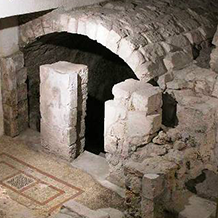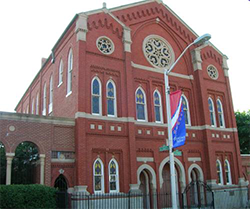Discovery of Buried Mikveh Prompts an Historical Overview of Baltimore’s Orthodox History
 The report last month that a 166-year-old mikveh, dating from, at the latest, 1845, had been uncovered under the historic Lloyd Street Synagogue in Baltimore, had deep resonance for The Jewish Voice and Opinion’s observer, social critic, and demographic analyst Catriel Sugarman. Mr. Sugarman, who authors The Jewish Voice’s periodic “Catriel’s Notebook” feature, was the last bar mitzvah ever celebrated in the Lloyd Street Synagogue.
The report last month that a 166-year-old mikveh, dating from, at the latest, 1845, had been uncovered under the historic Lloyd Street Synagogue in Baltimore, had deep resonance for The Jewish Voice and Opinion’s observer, social critic, and demographic analyst Catriel Sugarman. Mr. Sugarman, who authors The Jewish Voice’s periodic “Catriel’s Notebook” feature, was the last bar mitzvah ever celebrated in the Lloyd Street Synagogue.
“The year was 1957, when Sputnik was shot into space,” said Mr. Sugarman.
His late grandfather, HaRav Dovid Pattashnick, was the last spiritual leader of the congregation, the venerable Shomrei Mishmeres HaKodesh.
Deep Ties
A Greek Revival-style building, the Lloyd Street Synagogue, which is listed on the National Register of Historic Places, was the first shul building erected in Maryland and the third oldest Jewish house of worship still standing in the US. Now owned by the Jewish Museum of Maryland, it is open to the public as a museum in the Inner Harbor area of Baltimore.
Now a resident of Jerusalem, Mr. Sugarman still frequently visits the city where his mother was raised. He still has many cousins there who are all stalwart members of the Orthodox community.
“My ties to Baltimore coupled with my academic and social-science interest in Jewish demography, prompted me to explore the ramifications of the newly released Baltimore-Jewish population study, which shows that Orthodoxy is the fastest-growing movement in the community,” he said.
Private Meetings
Although Jews resided in Baltimore in Colonial times, there are no records of communal institutions. According Esther Doyle Read, who directed the excavations that uncovered the mikveh and serves as a lecturer in ancient studies at the University of Maryland, Jewish congregations in Maryland were barred by law from incorporating or owning property until 1828. Until then, she said, they would typically meet in private homes, where they would build their mikva’ot in basements.
The mikveh that was recently uncovered may have been one of those.
According to Mr. Sugarman, from the days of the legendary Rav Avraham Rice, spiritual leader of Congregation Nidche Israel (later Baltimore Hebrew Congregation) in the 1840s, the city has had a significant Orthodox presence.
Maintaining Tradition
Cong Nidche Israel was founded by predominantly German-Jewish immigrants in 1830, just after the law changed. Soon after, they hired Rabbi Rice, a German rav who engaged in an uphill battle against the Reform movement as well as assimilation and lax observance of Shabbat and kashruth. It was a position that placed him in constant conflict with many of his congregants.
For example, when he ruled that Sabbath desecrators should not be called to the Torah, the resistance in the shul forced him to back down. He allowed them to be called to the Torah, but, he said, no one should answer “amen” to the blessings they recited.
In 1842, as a result of his objections to the inclusion of Masonic rites at a Jewish funeral, a number of his congregants left his shul to form Har Sinai Verein, the first permanent Reform congregation in the United States.
New Building
 In 1845, the congregation relocated to the Lloyd Street site under the name Baltimore Hebrew Congregation (BHC). Designed by Baltimore architects Robert Cary Long, Jr and William Reasin, the brick building, with four Doric columns supporting a classic pediment, all painted white, is a near-twin of Baltimore’s St Peter the Apostle Church, which was designed by Mr. Long in 1842.
In 1845, the congregation relocated to the Lloyd Street site under the name Baltimore Hebrew Congregation (BHC). Designed by Baltimore architects Robert Cary Long, Jr and William Reasin, the brick building, with four Doric columns supporting a classic pediment, all painted white, is a near-twin of Baltimore’s St Peter the Apostle Church, which was designed by Mr. Long in 1842.
Under Rabbi Rice’s leadership, the shul either built or incorporated the mikveh that was recently uncovered and established one of the first Hebrew schools in the United States.
According to Ms. Read, the recently uncovered mikveh is, thus far, the oldest Jewish ritual bath ever discovered in the US.
In 1849, no longer able to resist the demand for liberal reforms, Rabbi Rice resigned from BHC and founded his own Orthodox shul. To maintain his financial independence, he opened a dry goods store and a grocery.
Burying the Mikveh
In 1860, BHC expanded the Lloyd Street building to the rear and tore down the old mikveh building, filling in the bath and burying it beneath their new addition. The excavations led by Ms. Read are taking place beneath what is now the basement floor of the 1860 addition.
“We found an area that had wood in it that began to drop rapidly below the level of the basement floor,” she said.
The archeologists, led by Ms. Read, have revealed about one-fourth of the original five-foot deep wooden tub, which is linked to a cistern and to remains of brick hearth once used to warm the bath’s water.
The dig has also unearthed a wealth of artifacts in the dirt which was used to fill in the mikveh, including broken wine bottles, crockery, buttons, and other domestic items, none of which date back later than 1860.
European Model
According to Avi Decter, executive director of the Jewish Museum of Maryland, the week the cistern was discovered, an article in a professional archeology journal described an excavation of a synagogue in Amsterdam dating back to 1723.
“And it had the same three elements—the bath, the cistern, and the hearth,” he said. “The idea of a ritual bath complex helps fill out the history of Jewish religious practice in this country.”
According to Ms. Read, similar mikveh complexes have been found in Germany and the Netherlands dating at least to the 1500s.
“The first congregation here was German, and they brought that cultural template to America,” she said.
It is unknown where or even if the Lloyd Street congregation built a new mikveh to replace the one that was buried in the 1860 expansion.
Reform Temple
In 1862, the congregants of BHC seemed to have had a change of heart. They asked Rabbi Rice to return to their pulpit, with the promise that it would remain strictly Orthodox.
A few months later, however, he died, and with him Orthodoxy in Nidche Israel/BHC. In 1871, an organ was introduced into the synagogue, and BHC became a Reform temple, which it still is.
In 1891, BHC moved to a larger location on Madison Avenue, selling the Lloyd Street building to the St John the Baptist Roman Catholic Church, a parish that served mainly immigrants from Lithuania.
Orthodox Again
But the Orthodox history of the Lloyd Street Synagogue was hardly over. In 1905, the church sold the building to a new Orthodox congregation, Cong Shomrei Mishmeres HaKodesh, which served Eastern European Jewish immigrants.
Just a few feet away from the recently unearthed mikveh stand a pair of two more modern, tile-lined mikva’ot, which were built and used by Congregation Shomrei Mishmeres HaKodesh.
“These are the mikva’ot I remember from my youth,” said Mr. Sugarman.
In 1917, the first all-day Hebrew day school outside of New York—the Hebrew Parochial School, later renamed the Talmudic Academy of Baltimore/Yeshivas Chofetz Chaim—was founded in Baltimore, and, in 1933, the now-world renowned Ner Israel Yeshiva opened.
“Similar to the rest of the country, by the 1920s and ’30s, the Orthodox community in Baltimore began to decline, and, by the 1950s and ’60s, Orthodox Jews became a small minority in the city that was once known as the ‘Jerusalem of America,’” said Mr. Sugarman.
Threatened Demolition
In the 1950s, the Lloyd Street Synagogue’s Congregation Shomrei Mishmeres HaKodesh fell victim to the shifting demography in Baltimore and, by 1963, in the face of threatened demolition, was forced to close.
“Many years ago, one of my uncles told me how my grandfather forcefully intervened when some of the remaining members wanted to sell the building to a pickle factory,” said Mr. Sugarman.
When word that the congregation was seeking to sell the building reached Wilbur Hunter, director of Baltimore’s Peale Museum, he alerted the Jewish community, and the Baltimore Board of Rabbis appointed a committee to investigate how the historic landmark might be preserved.
New Museum
The answer was the establishment of the Jewish Historical Society of Maryland, whose mission was to acquire, renovate, and maintain the Lloyd Street Synagogue. Eventually, the society morphed into the Jewish Museum of Maryland. In 1978, the building was listed on the National Register of Historic Places.
To Mr. Decter, the fact that several different religious groups utilized the building over the years makes this an “only-in-America” story.
“In Europe, Jewish and Christian congregations did not exchange buildings. But here in the US, we take over each other’s buildings regularly. It is a very powerful story for us,” he said.
A Namesake
The revitalization of the Orthodox community in Baltimore began in the late 1960s, just a few years too late for Shomrei Mishmeres HaKodesh.
“New yeshivot were founded as well as a Beis Yaakov School, and a plethora of new synagogues, filled with vibrant young families and oodles of children, opened their doors. The Orthodox community had come to life and, tentatively at first and then with growing confidence, bounced back,” said Mr. Sugarman.
In October 2006, Rabbi Chaim Schwartz, grandson and namesake of one of the three original trustees of Cong Shomrei Mishmeres HaKodesh on Lloyd Street, opened a Beit Midrash on Strathmore Avenue in the Upper Park Heights area of Baltimore.
“His goal was to resurrect the name and mission of the original Shomrei Mishmeres HaKodesh. Happily, the new shul is now a successful, delightfully hyperactive beit midrash teeming with young families. My grandfather would be ecstatic,” said Mr. Sugarman.





